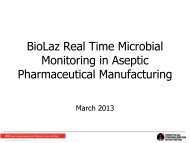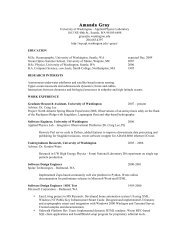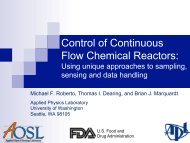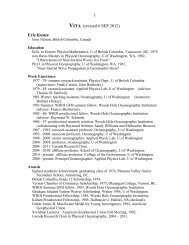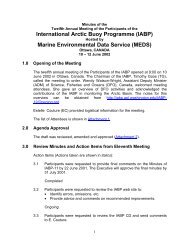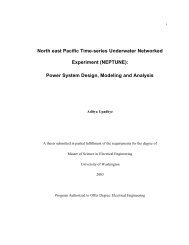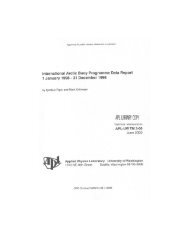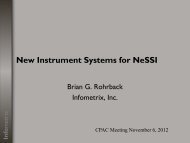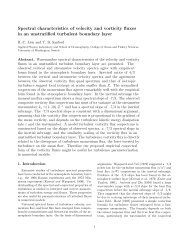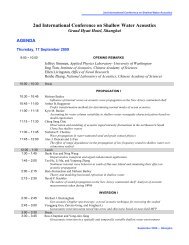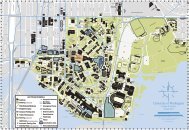Download/View - CPAC
Download/View - CPAC
Download/View - CPAC
You also want an ePaper? Increase the reach of your titles
YUMPU automatically turns print PDFs into web optimized ePapers that Google loves.
Overview of<br />
SPR Real-Time Biosensor System<br />
Clement E. Furlong, Professor, Departments of Medicine<br />
(Div. Medical Genetics) & Genome Sciences<br />
AOAC, Tacoma, WA 2012
Conflict of Interest Statement<br />
Clement Furlong and Scott Soelberg hold stock<br />
in Seattle Sensor Systems, a company which<br />
manufactures a portable SPR system.
Goals for Portable SPR Biosensor System<br />
• Rapid near real time detection &<br />
identification of analytes<br />
• Semi-Automated: minimum user input<br />
required<br />
• Few or no reagents<br />
• Low procurement and operational costs.
Sensor technology can be adapted to<br />
meet various requirements<br />
Packaging and collection<br />
system can be adapted for:<br />
• Toxin detection<br />
• Real-time process monitoring<br />
• Continuous air monitoring<br />
• Continuous monitoring of water systems<br />
• General laboratory research instruments<br />
• Bio-defense monitoring<br />
• Food monitoring<br />
• Medical diagnostics<br />
• Portable environmental monitoring
The SPIRIT system<br />
(Surface Plasmon Instrumentation for the Rapid Identification of Toxins)<br />
• Compact,<br />
lightweight (lunchbox<br />
size,
Refractive Index<br />
Reflectivity<br />
Fundamentals of<br />
1<br />
0.8<br />
Surface Plasmon Resonance<br />
0.6<br />
0.4<br />
0.2<br />
0<br />
0 20 40 60 80<br />
System software<br />
Ө Degrees<br />
1.3377<br />
1.3376<br />
1.3375<br />
1.3374<br />
1.3373<br />
1.3372<br />
1.3371<br />
1.337<br />
1.3369<br />
1.3368<br />
1.3367<br />
Sensorgram<br />
0 5 10<br />
Time, Min
Spreeta sensing components<br />
• Spreeta SPR components<br />
developed in collaboration<br />
with UW with TI<br />
• Miniaturized, robust, high<br />
performance devices.<br />
• Inexpensive in large quantity<br />
• Excellent manufacturing<br />
capabilities and quality<br />
control<br />
• Each sensor chip has 3<br />
independent channels<br />
Each Spreeta chip contains<br />
all of the optical<br />
components needed for<br />
sensitive SPR measurement<br />
of biomolecular interactions
Percent of 1 day wet<br />
Storage of Gold Slides<br />
140<br />
120<br />
100<br />
80<br />
60<br />
40<br />
20<br />
0<br />
Dextran 1<br />
Dextran 2<br />
Control<br />
0 50 100 150 200 250 300 350<br />
Time (days)<br />
Anti-Alkaline-phosphatase(AP)-antibody-coated slides were<br />
dried with a thin layer of 10 mM Tris, pH 8.0, 2.5% trehalose<br />
and 2.5% dextran. After extended storage, slides were wetted,<br />
exposed to AP and analyzed for AP activity.
SPIRIT performs 4-8 simultaneous<br />
measurements of antibody binding in<br />
triplicate<br />
Eight sensor chips<br />
Detection event<br />
Toxin<br />
Three active spots per sensor<br />
Flowcell
Examples of Assays Possible with SPR<br />
• Proteins by direct detection with or without<br />
amplification/verification<br />
-(protein toxins, industrial proteins, therapeutics)<br />
• Whole microbial cells<br />
-(F.tularensis, E. coli, Y. pestis)<br />
• Spores<br />
-(e.g., anthrax)<br />
• Viruses with or without amplification<br />
-(e.g. Norwalk, flu)<br />
• Small molecular weight analytes using displacement or<br />
competition assays<br />
-(e.g., domoic acid, cortisol, insecticides, toxic chemicals, TNT & other small<br />
organics)
Refractive index<br />
Analyte Detection and Signal Amplification<br />
1.3382<br />
1.3380<br />
1.3378<br />
1.3376<br />
1.3374<br />
1.3372<br />
1.3370<br />
1.3368<br />
0 50 100 150<br />
Time, min<br />
Signal Detection
Refractive index<br />
Analyte Detection and Signal Amplification<br />
1.3382<br />
1.3380<br />
1.3378<br />
1.3376<br />
1.3374<br />
1.3372<br />
1.3370<br />
1.3368<br />
0 50 100 150<br />
Time, min<br />
Signal Detection
Refractive index<br />
Analyte Detection and Signal Amplification<br />
1.3382<br />
1.3380<br />
1.3378<br />
1.3376<br />
1.3374<br />
1.3372<br />
1.3370<br />
1.3368<br />
0 50 100 150<br />
Time, min<br />
Signal Detection
Refractive index<br />
Analyte Detection and Signal Amplification<br />
1.3382<br />
1.3380<br />
1.3378<br />
1.3376<br />
1.3374<br />
1.3372<br />
1.3370<br />
1.3368<br />
0 50 100 150<br />
Time, min<br />
Signal Detection
Relative Refractive Index<br />
Detection of Microbes<br />
Detection and Verification of F. Tularensis (10 5 cfu/ml)<br />
1.3396<br />
Amplification/verification<br />
1.3394<br />
1.3392<br />
Detection<br />
Active channels<br />
anti-F.T #1<br />
anti-F.T #2<br />
anti-F.T. #3<br />
anti-Bot A NT #1<br />
anti-Bot A NT #2<br />
anti-Bot A NT #3<br />
1.3390<br />
Reference channels<br />
1.3388<br />
0 2 4 6 8 11 13 15 17 19 21 23<br />
Time (min)
RIU<br />
Virus Detection<br />
Norwalk VLP Detection<br />
Reference Subtracted, 0.75 mL Sample<br />
10^6 PFU/ml Norwalk VLPs<br />
Anti-Norwalk Amp<br />
180<br />
160<br />
140<br />
120<br />
100<br />
80<br />
60<br />
40<br />
20<br />
0<br />
-20<br />
-40<br />
-60<br />
Norwalk<br />
Amplification<br />
0 2.5 5 7.5 10 12.5 15 17.5 20 22.5<br />
Time (min)
Sensor response, RIU<br />
SEB binding rates, RIU/min<br />
Detection of Staphylococcal<br />
Enterotoxin B<br />
1.33525<br />
1.33520<br />
9.0E-05<br />
8.0E-05<br />
7.0E-05<br />
1.33515<br />
6.0E-05<br />
5.0E-05<br />
1.33510<br />
4.0E-05<br />
1.0E-05<br />
8.0E-06<br />
1.33505<br />
1.33500<br />
3.0E-05<br />
2.0E-05<br />
1.0E-05<br />
6.0E-06<br />
4.0E-06<br />
2.0E-06<br />
0.0E+00<br />
0 1 2 3 4<br />
1.33495<br />
0 20 40 60 80<br />
Time, min<br />
0.0E+00<br />
0 20 40 60 80 100<br />
SEB concentration, nM
RI<br />
Detection of 5 ng/mL (5 ppb; 33pM)<br />
BotNT (denatured botulinum toxin)<br />
1.3323<br />
1.33228<br />
1.33226<br />
1.33224<br />
1.33222<br />
1.3322<br />
1.33218<br />
1.33216<br />
1.33214<br />
1.33212<br />
1.3321<br />
Anti-Bot-toxin<br />
Reference<br />
Detect<br />
Amplify<br />
0 10 20 30 40<br />
Time (min)
Background-subtracted RIU<br />
Binding Rate (x10-6RIU/min)<br />
Direct Detection of Ricin A<br />
Chain (64 ppb-320 ppb)<br />
0.00009<br />
0.00007<br />
0.00005<br />
100 nM Ricin A Chain<br />
50 nM Ricin A Chain<br />
20 nM Ricin A Chain<br />
No Ricin A Chain<br />
14<br />
12<br />
10<br />
8<br />
0.00003<br />
0.00001<br />
6<br />
4<br />
2<br />
-0.00001<br />
0 200 400 600 800 1000<br />
0<br />
0 100 200 300 400<br />
Time (seconds)<br />
Ricin A Chain Concentration (nM)
Detection of Analytes in Complex Samples<br />
(e.g., saliva, plasma, urine, stools, sea water,<br />
fresh water, etc.)
Detection of 500 pM (14 ppb) SEB in urine<br />
Amplification<br />
500 pM SEB<br />
Wash<br />
(urine)<br />
From: Naimushin et al., Biosensors and Bioelectronics 17:573
Relative RIU<br />
Magnetic Nanoparticles Amplify the SPR signal<br />
Stepwise Detection of Staphylococcus<br />
enterotoxin B (SEB)<br />
10000<br />
1000<br />
50 ug/ml biotinylated<br />
anti-SEB monoclonal<br />
100 1<br />
(24 RIU)<br />
10 ng/ml SEB (13 RIU)<br />
10<br />
2<br />
3<br />
Streptavidin<br />
nanobeads (1075 RIU)<br />
Sensor<br />
~70 X<br />
Ready 1 2 3<br />
1<br />
0 10 20 30 40 50 60<br />
Time (min)
Detection of SEB in Different Matrices<br />
1 ng/ml<br />
in FCS<br />
1 ng/ml<br />
10 ng/ml<br />
Soelberg et al. Anal Chem 81: 2357 (2009)
Immuno Magnetic Bead Separation (IMS)<br />
Immuno Magnetic Bead Separation (IMS)
Immuno Magnetic Bead Separation (IMS)<br />
BChE
Detection of Small Molecules by SPR-<br />
A More Difficult Task
Competition Assay<br />
ANALYTE ATTACHED TO THE SURFACE<br />
•Small Analytes:<br />
•Estriol, Cortisol, Domoate…<br />
•Same analyte on the surface
Response<br />
NO ANALYTE PRESENT<br />
Competition Assay<br />
Time
Response<br />
Competition Assay<br />
ANALYTE PRESENT<br />
Time
Detection of Domoic Acid by<br />
Competition Assay<br />
Collaboration with Dr. Vera<br />
Trainer’s team at NOAA
Domoic Acid Concentration Curve<br />
Stevens et al. (2007) Harmful Algae 6: 166-174
Quantification of Cortisol<br />
100<br />
Detection slope (% of no cortisol sample)<br />
10<br />
1<br />
0.1<br />
1 10 100<br />
Cortisol concentration (ng/ml)
1/03 – 6/03: Airborne SPR Sensing<br />
Test Flights<br />
Variviggen instrumented with SPR sensors
MBARI AUV
Protein Nucleic Acids as Recognition<br />
Elements for DNA/RNA<br />
Very stable receptor on chip<br />
(Protein Nucleic Acid)<br />
Allows detection of target
RIU<br />
Sequential Detection of 8 Analytes<br />
200<br />
150<br />
100<br />
50<br />
Y. pestis<br />
10 6 CFU/ml<br />
Ovalbumin<br />
10 ng/ml<br />
SEB 5 ng/ml<br />
F. tularensis 5<br />
x 10 3 CFU/ml<br />
B. anthracis<br />
5 x 10 6 CFU/ml<br />
Norwalk VLPs<br />
5 x 10 9 particles/ml<br />
Ricin A<br />
chain 20<br />
ng/ml<br />
BG Spores<br />
9 x 10 4<br />
CFU/ml<br />
0<br />
-50<br />
-100<br />
0 20 40 60 80 100 120 140 160 180<br />
Time (min)
Conclusions<br />
• The portable, low cost SPIRIT (SPR) sensing<br />
system is versatile and adaptable for many<br />
different sensing applications.<br />
• The system is small enough to adapt to the<br />
NESSI platform<br />
• For additional information contact<br />
clem@uw.edu
SPIRIT Team & Sponsors<br />
• Medical Genetics /<br />
Genome Sciences<br />
Dr. Clement Furlong<br />
Scott Soelberg<br />
Joshua Probert<br />
• Electrical Engineering<br />
Dr. Sinclair Yee<br />
Tim Chinowsky<br />
Peter Kauffman<br />
Tony Mactutis<br />
• Texas Instruments:<br />
Jose Melendez<br />
Jerry Elkind<br />
Dwight Bartholomew<br />
John Quinn<br />
• Sponsors:<br />
Washington State Sea Grant<br />
Center for Process Analytical Chemistry (<strong>CPAC</strong>, UW)<br />
DOD<br />
Texas Instruments<br />
NIH/NSF



